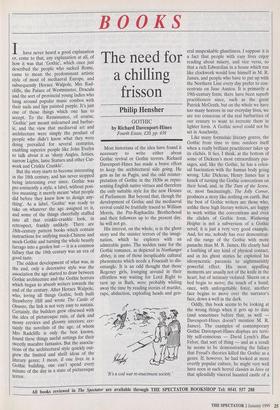BOOKS
The need for a chilling frisson
Philip Hensher
GOTHIC by Richard Davenport-Hines Fourth Estate, £20, pp. 438 Ihave never heard a good explanation or, come to that, any explanation at all, of how it was that 'Gothic', which once just described the people who sacked Rome, came to mean the predominant artistic style of most of mediaeval Europe, and subsequently Horace Walpole, Mrs Rad- cliffe, the Palace of Westminster, Dracula and the sort of provincial young ladies who hang around popular music combos with their nails and lips painted purple. It's just one of those things which one has to accept. To the Renaissance, of course, `Gothic' just meant unlearned and barbar- ic, and the view that mediaeval art and architecture were simply the product of people who didn't know what they were doing prevailed for several centuries, enabling superior people like John Evelyn to talk about it as `sharp Angles, Jetties, narrow Lights, lame Statues and other Cut- work and Crinkle Cranlde'.
But the story starts to become interesting in the 18th century, and has never stopped being interesting ever since. Gothic was pre-eminently a style, a label, without posi- tive meaning; it merely meant 'what people did before they knew how to design any- thing'. As a label, 'Gothic' was ready to take on whatever the age assigned to it, and some of the things cheerfully stuffed into all that crinkle-crankle look, in retrospect, frankly unlikely. There are 18th-century pattern books which contain Instructions for unifying mock-Chinese and mock-Gothic and turning the whole beastly farrago into a garden but — it is a common fallacy that the 18th century was an era of good taste. The oddest development of what was, in the end, only a decorative style was the association the age started to draw between Gothic architecture and the Gothic horrors which began to absorb writers towards the end of the century. After Horace Walpole, who, loving all things Gothic, both built Strawberry Hill and wrote The Castle of Otranto, the link is not very easy to sustain. Certainly, the builders grew obsessed with the idea of picturesque ruin, of dark and mossy crevices and gloomy interiors; cer- tainly the novelists of the age, of whom Mrs Radcliffe is only the best known, found these things useful settings for their sweetly macabre fantasies. But the associa- tions of the architectural style quickly out- grew the limited and shrill ideas of the literary genre; I mean, if one lives in a Gothic building, one can't spend every minute of the day in a state of picturesque terror. Most historians of the idea have found it necessary to write either about Gothic revival or Gothic terrors. Richard Davenport-Hines has made a brave effort to keep the architectural side going. He gets as far as Pugin, and the odd reinter- pretation of Gothic in the 1830s as repre- senting English native virtues and therefore the only suitable style for the new Houses of Parliament. But beyond that, though the development of Gothic and the mediaeval revival could be fruitfully traced to William Morris, the Pre-Raphaelite Brotherhood and their followers up to the present day, he will not go.
His interest, on the whole, is in the ghost story and the sinister terrors of the imagi- nation, which he explores with an admirable gusto. The sudden taste for the Gothic romance, as depicted in Northanger Abbey, is one of those inexplicable cultural phenomena which needs a Foucault to dis- entangle. It is an odd thought that those Regency girls, lounging around in their effortless way waiting for Lord Right to turn up in Bath, were probably whiling away the time by reading stories of murder, rape, abduction, exploding heads and gen- It's a cod war re-enactment society.' eral unspeakable ghastliness. I suppose it is a fact that people with easy lives enjoy reading about misery, and vice versa, so that a rich Edwardian in a house which ran like clockwork would lose himself in M. R. James, and people who have to put up with the Northern Line every day prefer to con- centrate on Jane Austen. It is primarily a 19th-century form; there have been superb practitioners since, such as the great Patrick McGrath, but on the whole we have too many horrors in our everyday lives, we are too conscious of the real barbarities of our century to want to recreate them in lighter form. A Gothic novel could not be set in Auschwitz.
Like many formulaic literary genres, the Gothic from time to time outdoes itself when a really brilliant practitioner takes up its clichés. It lies, I think, at the bottom of some of Dickens's most extraordinary pas- sages, and, like the Gothic, he has a colos- sal fascination with the human body going wrong. Like Dickens, Henry James has a knack of turning the Gothic conventions on their head, and, in The Turn of the Screw, or, most fascinatingly, The Jolly Corner, produces a story like nothing on earth. But the best of Gothic writers are those who, unlike these high literary writers, are happy to work within the conventions and even the clichés of Gothic form. Wuthering Heights is not a subversion of a Gothic novel; it is just a very very good example. And, for me, nobody has ever demonstrat- ed the range of the Gothic with more panache than M. R. James. He clearly had a loathing of any kind of physical contact, and in his ghost stories he exploited his idiosyncratic paranoia to nightmarishly powerful effect. His most appalling moments are usually not of the knife in the heart, but of intimacy violated. Sheets on a bed begin to move; the touch of a hand; once, with unforgettable force, another face begins to move over the narrator's face, down a well in the dark.
Oddly, this book seems to be looking at the wrong things when it gets up to date (and sometimes before that, as well Davenport-Hines doesn't mention M. R. James). The examples of contemporary Gothic Davenport-Hines displays are terri- bly self-conscious — David Lynch's Blue Velvet, that sort of thing — and as a result he seems to be demonstrating the fallacy that Freud's theories killed the Gothic as a genre. If, however, he had looked at more overtly popular culture, he might very well have seen in such horrid classics as Jaws or that splendidly visceral haunted castle of a movie, Alien, an unselfconsciously Freudi- an fantasy motivating a superbly orches- trated sequence of old-fashioned Gothic terrors. And a writer who prefers to talk about Jackson Pollock, on the grounds that he once produced a painting called 'Goth- ic', rather than about Psycho and The Exor- cist, which, to all intents and purposes, have been what Gothic has meant since the war, may be judged to have lost the plot.
All the same, this is an enjoyable book; I remember reading a lot of those Regency shockers as a boy, and am very glad to be reminded by someone else's labour that I never have to do so again, not because they are so terrifying, but because they are unbelievably dull.



























































 Previous page
Previous page